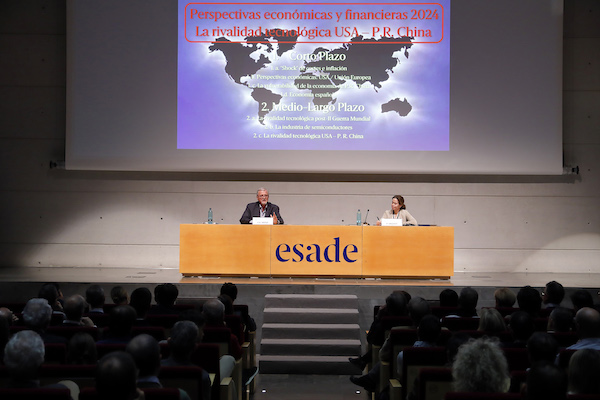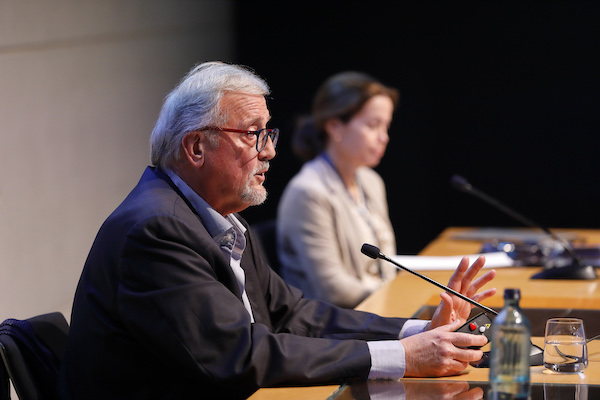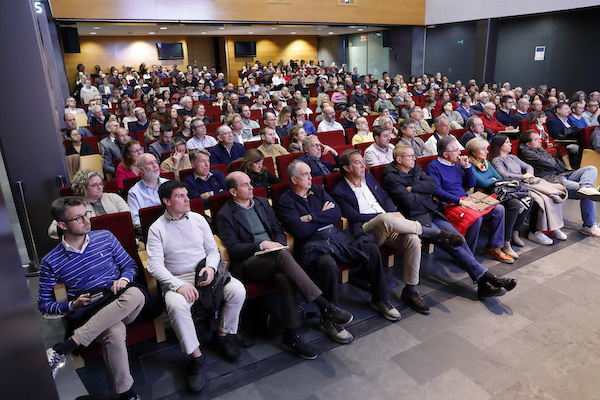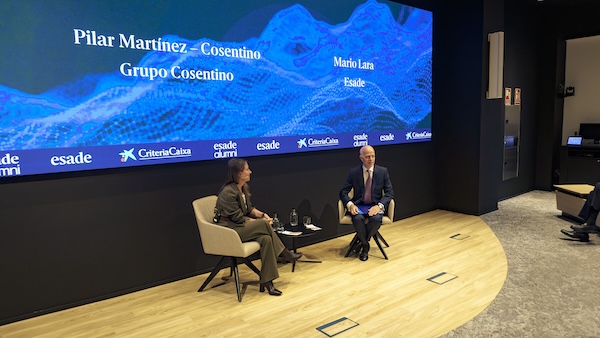The last session of Economic Perspectives analyzed the shift in the global economy and the turning point in global geopolitics

F. X. Mena, an Economics professor at Esade-University Ramon Llull and professor in the Department of Economics, Finance, and Accounting at Esade, started his talk by taking stock of the global economy, which is showing weaknesses in the United States and the European Union, dragged down by persistent inflation and high interest rates.
“We have experienced major upheaval (COVID, the invasion of Ukraine, and the conflict in the Middle East), which tax authorities met with major expansive policies and very high savings driving us. But the sticker shock has been ongoing and has translated into inflation, a withdrawal of monetary stimuli, and a rise in interest rates, all of which are affecting economic activity.”
Based on a readjustment of many of the imbalances, the 4.8% growth of the US economy is surprising. “It may not be worth fireworks, but it is the country that has reacted the best, with spectacular reindustrialization because president Joe Biden is concerned with the technological rivalry with China,” he stressed.
However, Europe’s economy is dropping into negative figures, and its main engine, the German economy, is on stand-by, while inflation has led the ECB to drastically increase interest rates, even though they are beginning to subside.
The Spanish economy, in turn, is dealing with the tax adjustments and structural reforms required by the European Commission in 2024: “In Spain, the per capita GDP is far under Europe’s, and our goal should be the European mean. We are witnessing increasingly sluggish growth rates, and even though our prospects are not forecasting a recession, we are looking at a soft landing. We have to get the changes in axes right because if not we’re going to end up at a dead-end.”

China, in turn, is not growing the way it used to and is still showing demographic imbalances, water and land imbalances, energy dependence, debt, corruption, and pollution. “I don’t think its economy is going to implode. Instead, it’s changing its economic model because it wants to be the world’s tech leader,” Mena reflected.
"We are witnessing increasingly sluggish growth rates, and even though our prospects are not forecasting a recession, we are looking at a soft landing"
Who will be the leader?
The second part of the lecture focused on the medium- to long-term consequences of the United States and China’s rivalry to become the global tech leader. “2024 will be the most important year in our lives because we’re going to witness a huge leap in artificial intelligence. We will find out who’s going to be the global leader, which is what the United States is and what China wants to be.”
Mena first offered a historical survey to explain the United States’s prime position as a tech power, given that it has been investing in technology since World War II. “It’s a country with lots of entrepreneurs. It has Silicon Valley and the top universities in the world which attract the top talent, and its internal consumption is very high. Competitors like Japan, South Korea, and the Soviet Union have cropped up, but it's always managed to outstrip them.”
Today, the country has the top semiconductor design companies, like Nvidia, even though they are manufactured in South Korea, Taiwan, and China. The semiconductor industry is fragmented: they are designed in one country, their memories in another, the machines to manufacture chips in another… Therefore, Washington is seeking to lower its international dependence on semiconductor manufacturing, create jobs, and bolster national security by building semiconductor factories which will enhance the internal tech sector as a defense strategy, as well as to avoid dependence on the international market in this sphere.

In this scenario, China is planning to be the tech leader of the world by 2024, as Xi Jinping has declared. But the president of the United States, Joe Biden, wants to keep his country’s tech leadership, and for national security reasons he has banned technology transfers to China and barred certain companies like Huawei from entering. This means that even though China has massively built up its semiconductor stocks, from now on it won’t be able to and Chinese companies will begin to wane if they are unable to keep up with the United States’s dynamism.
“2024 will be the most important year in our lives because we’re going to witness a huge leap in artificial intelligence. We will find out who will be the global leader, which is what the United States is and what China wants to be”
As professor Mena explained, the United States’s strategy is to run faster and further than the others. Even if China continues to develop, it will always lag behind it.
How is China responding? The new technologies require critical raw materials, and China is banning the export of raw materials that are critical for new technologies, like lithium, nickel and copper. Therefore, it is going to lead in certain sectors like electric cars and wind and solar energy, and keep up a rivalry in many areas, but not in cutting-edge technology or military energy.
To conclude the session, professor Mena offered a final reflection: “Complacency or inaction are pushing us backwards. If we want to ride the train of the future, we have to be very attentive in 2024.”




































